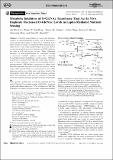Metabolic inhibitors of O-GlcNAc transferase (OGT) that act in vivo implicate decreased O-GlcNAc levels in leptin-mediated nutrient sensing
View/
Date
19/06/2018Author
Funder
Grant ID
095828/Z/11/Z
Keywords
Metadata
Show full item recordAbstract
O‐linked glycosylation of serine and threonine residues of nucleocytoplasmic proteins with N‐acetylglucosamine (O‐GlcNAc) residues is catalyzed by O‐GlcNAc transferase (OGT). O‐GlcNAc is conserved within mammals and is implicated in a wide range of physiological processes. Here we describe metabolic precursor inhibitors of OGT suitable for use both in cells and in vivo in mice. These 5‐thiosugar analogues of N‐acetylglucosamine are assimilated through a convergent metabolic pathway, most likely involving N‐acetylglucosamine‐6‐phosphate de‐N‐acetylase (NAGA) to generate a common OGT inhibitor within cells. Of these inhibitors, we show that 2‐deoxy‐2‐N‐hexanamide‐5‐thio‐D‐glucopyranoside (5SGlcNHex) acts in vivo to induce dose‐ and time‐dependent decreases in O‐GlcNAc levels in various tissues. Decreased O‐GlcNAc correlates, both in vitro within adipocytes and in vivo within mice, with lower levels of transcription factor Sp1 and the satiety‐inducing hormone leptin ‐ revealing a link between decreased O‐GlcNAc levels and nutrient sensing in peripheral tissues of mammals.
Citation
Liu , T-W , Zandberg , W F , Gloster , T M , Deng , L , Murray , K D , Shan , X & Vocadlo , D J 2018 , ' Metabolic inhibitors of O -GlcNAc transferase (OGT) that act in vivo implicate decreased O -GlcNAc levels in leptin-mediated nutrient sensing ' , Angewandte Chemie International Edition , vol. 57 , no. 26 , pp. 7644-7648 . https://doi.org/10.1002/anie.201803254
Publication
Angewandte Chemie International Edition
Status
Peer reviewed
ISSN
1433-7851Type
Journal article
Description
This work was supported by a grant from the Natural Sciences and Engineering Research Council of Canada (NSERC). D.J.V. is a scholar of the Michael Smith Foundation of Health Research (MSFHR) and a Tier II Canada Research Chair in Chemical Glycobiology. T.M.G. was supported by a Sir Henry Wellcome postdoctoral fellowship (WT082572) and a Research Career Development Fellowship from the Wellcome Trust (WT095828).Collections
Items in the St Andrews Research Repository are protected by copyright, with all rights reserved, unless otherwise indicated.

